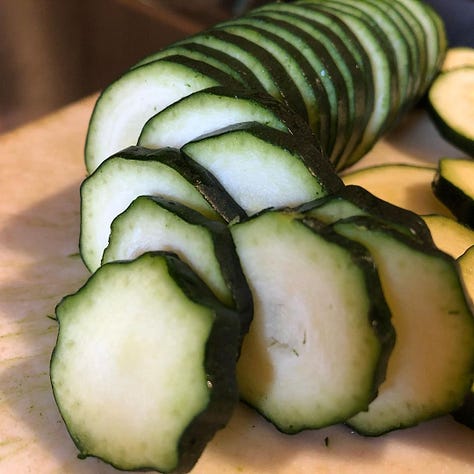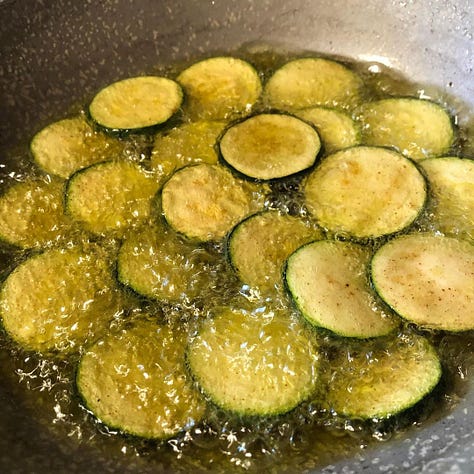The Complex Past of Concia
When a recipe for fried zucchini launches a deep dive into the Italian language



Cari amici,
I have a treat for you this week, a guest post by Giorgia Meschini, a native Roman who writes “Puntarelle: life in Rome,” a funny and fascinating Substack that combines language, opera, classicism, food, snarkiness, and daily life in Italy in delightful ways. She also writes a Substack for lovers of everything Baroque, sometimes in two languages, which you should definitely check out.
Because I like everything Giorgia writes, I gave her free rein for today’s letter. So without further ado, here’s what she came up with.
A couple of days ago, as I was perusing Substack Notes during the most boring journey towards Eboli, my parents' hometown, I saw this post about marinated zucchini by Mitchell Davis, in which he writes:
Fried in olive oil, layered with a mixture of chopped fresh basil, mint, and garlic, and doused with vinegar, the dish is known in Rome as concia, which Leah tells us derives from an old Roman term for hanging laundry to dry in the sun, a reference to the drying of the zucchini that is how the recipe begins.
“Hmm . . .” the middle-aged Hermione Granger in me thought, “that isn't entirely correct.” (Yes, I am frustratingly annoying, I know. But I also have flaws.)
And so I decided this would be what I would write about for “Italicus”: not zucchini, but the meaning of the word concia, its origin, and a handful of other sister words and sayings that have the same etymological root, but interestingly enough not the same meaning. Because the Italian language is fun, but can also be a pain in the side, and not just for foreigners trying to get their head around it.
First things first, the word concia has nothing to do with laundry: it originates from the Latin word cōmptum, the perfect passive participle of cōmere, which means . . . a bunch of things, depending on context, but primarily “to cure,” not as in the medical way, but as in curing tobacco, for instance, or tanning leather. Conciatore is in fact the Italian word for tanner.
But apart from that, there are a lot of other words and modi di dire (common expressions) that derive from conciare, and none of them involves tanning leather, nor curing tobacco.
One of the several meanings of the verb conciare is dialectal for “to season food,” especially vegetables, hence concia di zucchine simply means seasoned zucchini, and it doesn’t refer to zucchini being “sun dried” (also because they're not sun dried, they're fried in oil!). You don't sun dry lettuce, either, and that's why my paternal nonna, Anastasia, used to say “cunza ’a ’nzalata!” when she wanted someone to season the salad.
By the way, I have my own recipe for concia di zucchine: I slice them transversally instead of longitudinally, fry them in EVO oil, then make my emulsion for the seasoning leaving the basil out and adding oregano instead, and, above all, using balsamic vinegar instead of plain. Yum!
In Veneto the dialectal verb conzsar just means either to season/flavor or to tan leather, while in Sicily the equivalent dialectal verb cunzari can also mean “to set the table” (cunzari la tàvula), “to make one’s bed” (cunzari lu lettu), or generally get something ready.
Acconciare also derives from conciare, and means fixing something, but also arranging a hairdo (in fact acconciatore is another way to say “hairdresser”), dressing up something, or arranging something in a beautiful fashion (flowers, for instance). On the other hand, conciare, again, could also mean you're not that beautifully arranged at all, you're actually quite in a state: “ma come ti sei conciata?” (i.e., look at the state of you!) is what my mother would say to little me coming back home a complete mess from a playground, with my clothes and hands and face all dirty. (I won't mention here that time I caught a pinworm infection because I ate soil while playing in Villa Sciarra.)
“Come ti sei conciato?” also means “What the heck are you wearing?”—what someone who is (or at least thinks he/she is) more fashion-savvy than the recipient of such a remark says, not really expecting an answer from them, because “Come ti sei conciato?” is just a judgment passed off as a question.
If you hear someone say “Ora ti concio per le feste!” you should be ready for either fight or flight, because they don't want to “season you for the holidays” (as a literal translation would suggest), but they do want to beat you up—and that could also be your mum being really mad at you for something you’ve said or done as a kid, so “Ora ti concio per le feste!” would be declared while furiously waving either a slipper or a wooden spoon, just to make sure you understand she’s not talking about seasoning vegetables. (Well, at least that used to happen when us Gen Xers were little. I am told today’s mums’ parental approach is different.)
Dante Alighieri, in the XXX canto of his Inferno, tells about his journey through the eighth circle of Hell, called Malebolge, where he sees a damned soul molesting another, so he asks another damned soul there, poet and alchemist Griffolino d'Arezzo, to explain the scene:
E l'Aretin che rimase, tremando / mi disse: “Quel folletto è Gianni Schicchi, / e va rabbioso altrui così conciando.”
(And the Aretine, who trembling had remained, / Said to me: “That mad sprite is Gianni Schicchi, / And raving goes thus harrying other people.”)
(English translation by Henry Wadsworth Longfellow.)
Who was this Gianni Schicchi dude, and what was he doing down there in hell? You may already know his name if you’re an opera lover, as there’s a famous comic opera by Giacomo Puccini about him. Anyway, Gianni Schicchi was a Florentine knight in the 13th century, and in Dante’s tale he’s condemned to eternal insanity in hell for having been a fraudster, so he was “conciando per le feste” another damned soul, not by beating him up with a wooden spoon or a slipper like Italian mums used to do, but by biting his neck.

But wait, there's more! If you've ever seen a wall, a building made of stone, then you've seen a concio (which is not the male version of a concia, so nobody is seasoning said building with chopped herbs, garlic, and vinegar, in this case; in fact a concio is an ashlar (masonry made of square-cut stones) or a voussoir (a keystone, a springer)—and yes, the term still comes from the same verb, conciare, because in architecture that also indicates cutting a block of stone, making it square-ish.
There, I've just made decades of classical and architecture studies useful (sort of), at last!
© Giorgia Meschini 2023
Alla prossima,
Cheryl
P.S. My book! Which you can buy here or on the usual sites. Another fab option is to ask your local library to stock it.
If you read it and like it, please tell your friends and/or leave a few lines of praise on any bookish site. You’ll make me over-the-moon happy. Baci!






